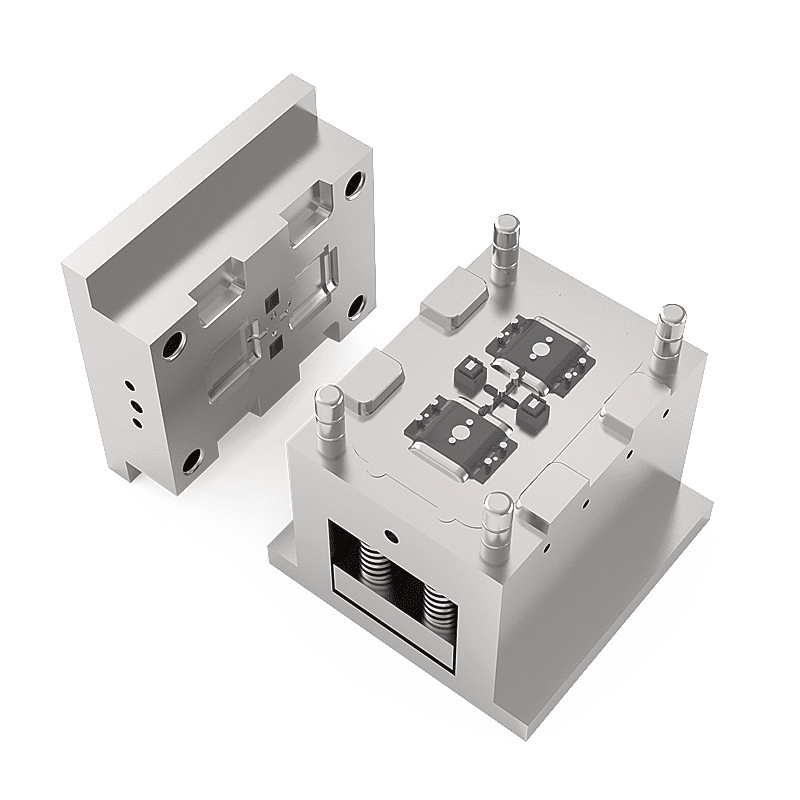
When designing plastic molds, after determining the mold structure, each part of the mold can be designed in detail, that is, to determine the size of each template and part, cavity and core size. Major design parameters such as material shrinkage are involved. Therefore, the size of each part of the cavity can be determined only by specifically mastering the shrinkage rate of the formed plastic. Even if the selected mold structure is correct, but the used parameters are improper, it is impossible to produce qualified plastic parts.
Plastic shrinkage rate and its influencing factors
Thermoplastics are characterized by expansion after heating, contraction after cooling, and of course, the volume will shrink after pressure. In the process of injection molding, the molten plastic is first injected into the mold cavity, after filling, the molten material is cooled and solidified, and the shrinkage occurs when the plastic part is removed from the mold, which is called forming contraction. During the period of time from the mold to the stability of the plastic parts, the size will still change slightly, and one change is to continue to shrink, which is called post-contraction.
Another change is that some hygroscopic plastics expand due to hygroscopicity. For example, when the water content of nylon 610 is 3%, the size increase is 2%; When the water content of glass fiber reinforced nylon 66 is 40%, the size increase is 0.3%. But the main role is the plastic contraction.
At present, the method of determining the shrinkage rate of various plastics (forming contraction + post-contraction) is generally recommended in the German national standard DIN16901. That is, the difference between the mold cavity size at 23 ° C ±0.1 ° C and the corresponding plastic part size measured at 23 ° C and 50±5% relative humidity for 24 hours after forming is calculated.
The shrinkage rate S is expressed by the following formula: S={(D-m)/D}×100%(1)
Where: S- shrinkage rate; D- Mold size; M- Dimensions of plastic parts.
If the mold cavity is calculated according to the known plastic part size and material shrinkage rate, it is D=M/(1-S). In order to simplify the calculation in the mold design, the following formula is generally used to find the mold size:
D=M+MS(2)
If more precise calculations are required, the following formula should be applied: D=M+MS+MS2(3)
However, in determining the shrinkage rate, because the actual shrinkage rate is affected by many factors, only approximate values can be used, so the calculation of cavity size with formula (2) basically meets the requirements. In the manufacture of the mold, the cavity is processed according to the lower deviation, and the core is processed according to the upper deviation, so that it can be properly trimmed when necessary.
The main reason why it is difficult to accurately determine the shrinkage rate is, first of all, because the shrinkage rate of various plastics is not a fixed value, but a range. Because the shrinkage rate of the same material produced by different factories is not the same, even the shrinkage rate of different batches of the same material produced by a factory is not the same. Therefore, each factory can only provide users with the shrinkage range of the plastic produced by the factory. Secondly, the actual shrinkage rate in the forming process is also affected by factors such as the shape of the plastic part, the mold structure and the forming conditions. The effects of these factors are described below.
Shape of plastic parts
For the wall thickness of the forming part, the shrinkage rate is generally larger due to the longer cooling time of the thick wall, as shown in Figure 1. For general plastic parts, when the difference between the molten flow direction L size and the size perpendicular to the molten flow direction W size is large, the shrinkage difference is also large. From the flow distance of molten material, the pressure loss of the part away from the gate is large, so the shrinkage rate there is also larger than that near the gate. Because the shapes of reinforcement bars, holes, bosses and engravings have shrinkage resistance, the shrinkage rate of these parts is small.

Mold structure
The form of the gate also affects the shrinkage rate. When using a small gate, the shrinkage rate of the plastic part increases because the gate is cured before the end of the pressure holding. The structure of cooling loop in injection mold is also a key in mold design. If the cooling circuit is not properly designed, the shrinkage difference will occur due to the uneven temperature of the plastic parts, and the result is that the size of the plastic parts is out of whack or deformed. In the thin-walled part, the influence of mold temperature distribution on the shrinkage rate is more obvious.
Forming condition
Barrel temperature: When the barrel temperature (plastic temperature) is high, the pressure transfer is better and the shrinkage force is reduced. However, when using a small gate, the shrinkage rate is still large because the gate is cured early. For thick wall plastic parts, even if the cylinder temperature is higher, the shrinkage is still larger.
Feeding: In the forming conditions, minimize feeding to keep the size of the plastic parts stable. However, insufficient feeding can not maintain the pressure, and will increase the shrinkage rate.
Injection pressure: Injection pressure is a factor that has a greater impact on the shrinkage rate, especially the pressure holding page number 335 after filling. Under normal circumstances, when the pressure is larger, the shrinkage rate is smaller because of the density of the material.
Injection speed: Injection speed has little effect on shrinkage rate. However, for thin-walled plastic parts or very small gates, and when using reinforced materials, the shrinkage rate is small when the injection speed is increased.
Mold temperature: Usually the shrinkage rate is larger when the mold temperature is higher. However, for thin-walled plastic parts, if the mold temperature is high, the flow impedance of the molten material is small, and the shrinkage rate is small.
Forming cycle: The forming cycle is not directly related to the shrinkage rate. However, it should be noted that when the forming cycle is accelerated, the mold temperature and melt temperature must also change, which also affects the change of the shrinkage rate. When making material tests, the forming cycle determined by the required yield should be formed and the size of the plastic part should be checked.
Examples of plastic shrinkage test using this mold are as follows. Injection machine: locking force 70t screw diameter Φ35mm screw speed 80rpm Forming conditions: Maximum injection pressure 178MPa cylinder temperature 230(225-230-220-210)℃ 240(235-240-230-220)℃ 250(245-250-240-230)℃ 260(225-260-250-240)℃ Injection speed 1425px3/s Injection time 0.44 ~ 0.52s Holding time 6.0s cooling time 15.0s
Mold size and manufacturing tolerances
In addition to the basic dimensions calculated by D=M(1+S) formula, there is also a problem of machining tolerance. According to the convention, the machining tolerance of the mold is 1/3 of the tolerance of the plastic part. However, due to the differences in the shrinkage range and stability of plastics, the dimensional tolerances of the plastic parts formed by different plastics must first be rationalized. That is, the dimensional tolerance of plastic forming parts should be larger by the larger shrinkage range or the poorer shrinkage stability. Otherwise, there may be a large number of out-of-size waste products.

To this end, countries have specially formulated national standards or industry standards for dimensional tolerances of plastic parts. China has also formulated ministerial professional standards. But most of them have no corresponding dimensional tolerance of the mold cavity. The German national standard has specially formulated the DIN16901 standard of dimensional tolerance of plastic parts and the corresponding DIN16749 standard of dimensional tolerance of mold cavity. This standard has a greater impact in the world, so it can be used as a reference for the plastic mold industry.
Dimensional tolerances and allowable deviations of plastic parts
In order to reasonably determine the dimensional tolerance of plastic parts formed from materials with different shrinkage characteristics, the concept of forming shrinkage difference △VS is introduced in the standard. △VS = VSR_VST(4)

Where: VS- forming shrinkage difference VSR- Forming shrinkage in the direction of molten flow VST- Forming shrinkage in the direction perpendicular to molten flow.
According to the △VS value of plastics, the shrinkage characteristics of various plastics are divided into 4 groups. The group with the smallest △VS value is the high-precision group, and so on, the group with the largest △VS value is the low-precision group. Precision technology, 110, 120, 130, 140, 150 and 160 tolerance groups have been developed according to basic dimensions. It is also stipulated that the dimensional tolerances of the plastic forming parts with the most stable shrinkage characteristics can be selected from groups 110, 120 and 130. The dimensional tolerances of molded plastic parts with moderately stable shrinkage characteristics are 120, 130 and 140.
If the dimensional tolerance of such plastic forming plastic parts is 110 group, a large number of dimensional out-of-tolerance plastic parts may be produced.
Groups 130, 140 and 150 are selected for dimensional tolerances of molded plastic parts with poor shrinkage characteristics. Groups 140, 150 and 160 are selected for dimensional tolerances of molded plastic parts with the worst shrinkage characteristics. The following points should also be noted when using this tolerance table. The general tolerances in the table are used for dimensional tolerances where no tolerances are indicated. The tolerance for directly marking the deviation is the tolerance band used to mark the tolerance for the size of the plastic part.
The upper and lower deviation can be determined by the designer himself. For example, the tolerance zone is 0.8mm, then the following kinds of upper and lower deviations can be selected. 0.0; 0.8; + / – 0.4; 0.2; -0.5 etc. Each tolerance group has two tolerance values, A and B. Where A is the size formed by the combination of mold parts, which increases the error caused by the incompatibility of mold parts. This added value is 0.2mm. Where B is the size directly determined by the mold part. Precision technology is a set of tolerance values specially established for the use of plastic parts with high precision requirements. Before using plastic tolerances, it is first necessary to know which tolerance groups are applicable to the plastics used.

Manufacturing tolerance of the mold
The German national standard has formulated the corresponding mold manufacturing tolerance standard DIN16749 for plastic parts tolerances. The table has four tolerances. Regardless of the material of the plastic parts, the mold manufacturing tolerances that do not indicate the dimensional tolerance dimensions are used the tolerance number 1. The specific tolerance value is determined by the basic size range. No matter what kind of material plastic parts of medium precision size mold manufacturing tolerance is the tolerance of number 2. The mold manufacturing tolerance of the higher precision size of the plastic parts of any material is the tolerance of the serial number 3. The corresponding mold manufacturing tolerance for precision technology is the tolerance of serial number 4.
Reasonable tolerances of various materials and corresponding mold manufacturing tolerances can be reasonably determined, which not only brings convenience to mold manufacturing, but also reduces waste products and improves economic benefits.

